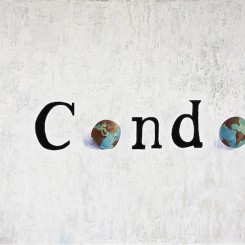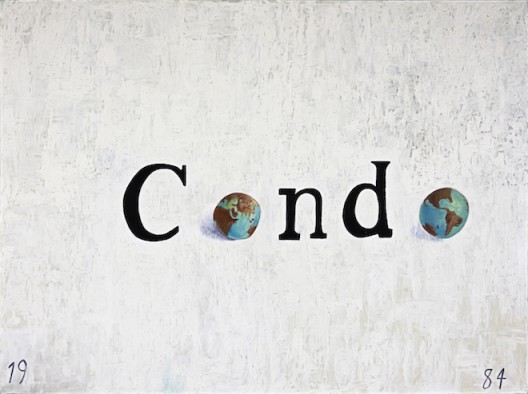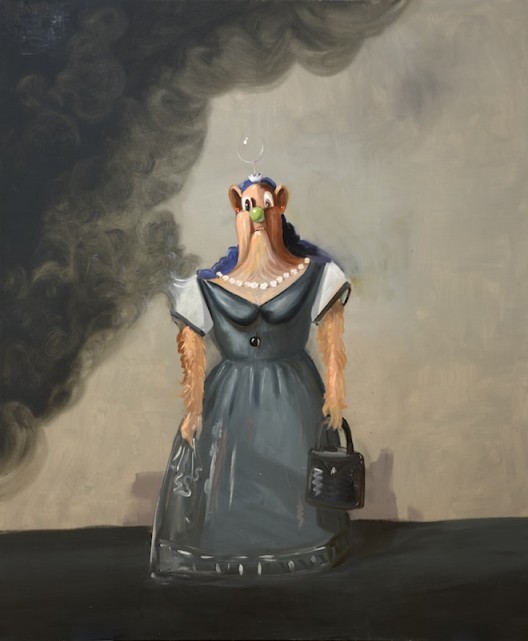Exploring the Extreme Vision of George Condo’s Work
“Expanded Portrait Compositions”
Hong Kong Maritime Museum
27 Mar 2018 – 06 April 2018
George Condo’s first solo show in Hong Kong, “Expanded Portrait Compositions”, opens at the Hong Kong Maritime Museum. Organized by Sprüth Magers and Skarstedt, it comprises major new work by one of the most influential living painters. A major sculpture by George Condo will also be on view at Almine Rech Gallery and Simon Lee Gallery at Art Basel Hong Kong.
Ran Dian’s Chris Moore recently spoke with George Condo about the show, Basquiat and falling down stairs with a painting.
Chris Moore: You’re planning a show for Hong Kong?
George Condo: Yes.
CM: Where are you at with that now?
GC: Fairly well along to be honest. I’ve been enjoying working on it. What I have in mind is, I’m going to show some figure compositions on canvas and then some abstractions that are based on the human portraits . . . it’s just an interesting prospect to be working towards a show in Hong Kong rather than let’s just say having something in an art fair.
CM: Is this your first time in China?
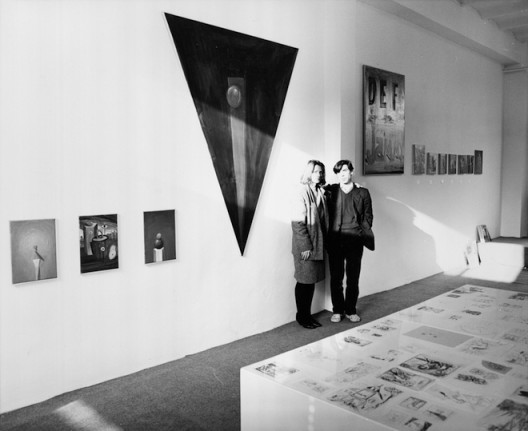
Monika Sprüth, George Condo at the exhibition ‘Bilder-Zeichnungen’,
Monika Sprüth Galerie, Cologne, 1984 © Sprüth Magers
GC: Yes. I had something in Beijing years ago when the Pace Gallery first opened there in 2008. It will be my first real solo exhibition.
CM: [laughs] Well, that’s a good way to put it! I know that you’re going to have some figurative work and some abstract work, and I’ve just been reading that you don’t think that there is such a thing. Abstract and figurative, it’s actually all the same thing.
GC: Well it is. In my opinion, from let’s say a philosophical perspective, in the picture plane, a figure and an abstraction basically represent some reflection of the human mind more than they reflect whatever it is that they supposedly represent. I don’t think there’s a difference and I don’t think that the critical discussion on portraiture or abstract painting has really explained the similarities between the two things all that concisely. I feel as if it leans towards the easier way of describing things as something abstract being purely abstract. Whereas nothing is abstract unless it’s abstracted from reality or from some recognizable form. Otherwise in fact, it’s not an abstraction; it’s just a thing and nothing more.
CM: —It’s terminology to allow you to speak about something, and this is the term real or artificial, abstract or figurative. These are artificial terms in the first place. We use them because that’s what we need in order to express ourselves with language.
GC: Well yes, but the language itself can evolve to further explain things in a more concise manner, for example, and it does when it comes down to deciphering the being or the appearance of being for a particular object.
For example, a Modigliani portrait; are we looking at the appearance of being or are we looking at the representation of being, in the sense of that person that was originally sitting there is now an abstract representation of that original person. What is that? It’s a transmission from the artist onto a canvas that supersedes the original object that he is representing. I think that transposition of the artist’s sense of reality and reality itself is quite exciting in art. Not to mention, that a painting in and of itself is not a human.
CM: I think this is what gets lost a lot in more recent painting that we’re seeing. There’s been so much generalized abstraction out there. There’s mixing of concepts. With cubism, it’s not about how a painting is made but how you look at a painting.
GC: Yes, and how you look at that object as a painting. Also, when you talk about Cubism, it’s the way that we can see things by simply moving around a table. But when you’re dealing with a frozen image—that’s what I mean by a picture plane, where it could only exist upon that picture plane but can be seen from the different angles if you were to walk around the object simultaneously—where I’ve talked about psychological cubism, we can explore in one single portrait the various different conflicting and contrasting and harmonious, let’s say, emotional states of mind, all at the same time. In other words, you’re seeing somebody, two weeks ago that was having a mental breakdown, and then two weeks later, having the best day of their life, simultaneously. The time lapse between those particular emotions doesn’t necessarily have to be within the split second that you’re observing them.
We’re also thinking about the viewer. In order to fully understand a painting, one does have to somehow interpret the viewer. . . If you walk up to somebody staring at the “Mona Lisa” and you ask ten people what they are looking at, they’ll probably all tell you the same thing, and it’s something they read somewhere before, “Looking at her smile and trying to figure it out.” They might tell you something that’s a preconceived notion, but if you really dig into their psyche and actually try to find out what they are seeing, they might be seeing more of an autobiographical sketch in their mind and trying to find a way out of it personally.
In other words, they are looking at something that they don’t necessarily want to have as a personal representation, other than an experience of having seen it, but in fact, with good art, you basically see yourself in it when you look at it. When you look at a great work of art, somewhere along the line you see yourself. And this is what they most often shy away from. You see yourself either in an abstraction or a figurative work. Even in a landscape you see yourself. You see yourself imagining being in that landscape because it looks so beautiful. You look at a Monet, and you see yourself going there and standing in the shadows looking at the flowers. You know what I mean?
CM: Well think of people looking at your pictures and how they’re feeling!
GC: Well, I do! I think they see themselves; they see themselves having a nervous breakdown [laughs].
CM: People are projecting into it. This is their way of empathizing; it’s how they relate to what they’re seeing. It’s the simplest emotion, very, very human, the most immediate. But at the same time, you’re also framing that person. You’re catching them unawares, and saying, “Here you go, this is you!”
GC: Yes—this is you! And all of us!
CM: When you’re making a work, there’s the process of making, and it changes over time. You might have a clear idea of what you want to do, to begin with, but in the very process there’s this whole thinking rigmarole that’s going on, and you’re looking at it and it’s changing. Look at something like “Cat Faced Nun” (2010) where you got to a certain point, and there’s this cat and it’s almost like you just tried to scrub it out. Or it’s like that moment where the Picasso looks at Gertrude Stein saying, “I can’t see you anymore?”
Falling Down the Stairs
CM: Are you at the changing point now? Because I was looking at your “The End of Bank Street” (2016) …
GC: [laughs] “The End of Bank Street” was about the last painting I ever did at that place that I was living at on Bank Street in the West Village. It ended up in a very rough situation because I was running down the stairs and my shoe fell off. I slammed down the stairwell on to my face, and ended up having to go to the emergency ward. I had this incredible black eye. I thought, “Jeez, I must have broken something.” But I hadn’t. When I came back, I was fine. I just looked like I’d been in a boxing match.
(CM: It’s surprising how often George Condo has had accidents or some health scare or other, whether falling down stairs or Legionnaire’s Disease in Berlin. Just read on.)
Everything was starting to deteriorate at Bank Street. There was one diptych upstairs that I had started on New Year’s Eve. For some reason, I was out at a bar by myself, and all these characters that were in the bar and they all said, “Let’s go back to your house. We all want to be painted.” I painted all these lunatics that I’d just met that night. Then I threw them out of the house about two in the morning and said, “Alright I’m going to bed.”
After I fell down the stairs a week later, I went upstairs and I just realized: this painting is going to have to fall down the stairs. It turned out to be a cool piece because it was a total car crash painting, figurative abstraction and just throwing everything at it that I had in the studio. I knew I was leaving and that was going to be the last painting I was ever going to make at that place. It was like, what a way to end a two-year rental? That was The End of Bank Street. I was glad it was over, I got to say.
CM: Do you feel like you’re shifting in a new direction? It’s so hard to say for somebody who can adapt and absorb and steal from so many of the painters of art history, and then you can come up with your own thing.
GC: You have to look at it like: if you are obsessed with art as an artist, and you love art, rather than just say go to an exhibition at the Met or the Prado, the first time an artist goes to the Velázquez room at the Prado, and if they don’t come back so impressed that something of that room doesn’t end up in their paintings, they either missed it, or it’s not impressive enough to them.
In my case, it leaves such a deep impression on me, art. And that goes back to looking at it and thinking to myself, “Wow, how did he do that? How did he make that? How did he control his palette to the point where there’s maybe four or five colors used, but they’re creating so many different tonalities, hues, shades?” There’s so much going on that that’s a true master. And I want to go back, and I want to paint something. I don’t necessarily want to replicate the subject matter of the painting. What I want to do is apply that technical information to my own content. By doing that you superimpose, to a certain degree, the presence of that art. You’re simply referencing the way something looks but not the actual look. You’re replicating the look of something without that something that it looks like.
In other words, I might get a lot out of Goya’s (1746-1828) black paintings, but I’m going to transpose that information into my own subject matter. It’s quite evident, in my case and I think in a lot of artists’ cases whose works I like, you can feel it. If I look at Cézanne (1839-1906); it’s pretty obvious that he was impressed with Chardin’s (1699-1779) still-lifes and that he found a way to retain the presence of Chardin and his still-lifes and break free from just being an artist who quoted Chardin. Or that Picasso was very impressed with Rembrandt; he was very impressed with Toulouse-Lautrec, totally impressed with Cranach (1472-1553). He was totally impressed with Degas’s brothel scenes. He was impressed with “Las Meninas” (1656), impressed with the “Le Déjeuner sur l’herbe” (1863). He took all those pieces and those paintings; he literally took them apart and dissected them and recomposed the parts to create something of those subjects. In his case, he did use the subject matter and painted it his own way.
In my case, I don’t use the subject matter. I just use the technical information of how those subjects were created. That’s the difference between my work and Picasso’s. I don’t actually go out there and do the “Le Déjeuner sur l’herbe”. I may just simply say, it’s figures in a garden. The black is painted with a blue and a black combined, mixed with a brown and a black combined, which gives you a different alternation of depth, like someone like Frans Hals (1582-1666) might do. All of a sudden, you’ve got Frans Hals’ blacks that most likely Manet had studied or Velazquez’s blacks that Manet had obviously studied and they’ve transposed that use of how to work the color black into their paintings.
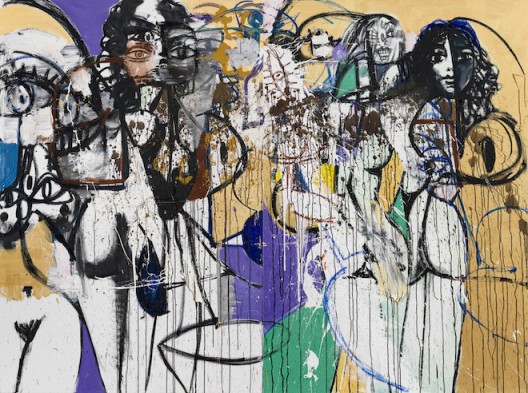
George Condo, “The End of Bank Street”, oil pigment stick and metallic paint on linen, 182.9 x 248.8cm, diptych, 2016 © Sprüth Magers
Jean-Michel Basquiat and John Coltrane
CM: There are very few artists working contemporarily now that I can compare with you. You’ve really gone off on your direction, completely. What other artists were around you? You feel somehow it’s not the same ideas but the same approach as well. I could mention Basquiat (1960-1988) given that you and he were friends.
GC: Yes. Take for example Jean-Michel’s work. He was well aware of de Kooning; he was well aware of Cy Twombly (1928-2011), he was well aware of Picasso’s primitivist paintings, taking African sculptures and working them into Western philosophical paintings. He was aware of all that. Then he combined that with the rejection of low art or street art. He brought it up to the level of—and in his case improvising on styles of those particular painters—because he was very into Charlie Parker, very into jazz—the way those jazz artists improvised on popular themes in music. They might do a “standard”, like the way John Coltrane did “My Favorite Things”; it’s a Rodgers and Hammerstein tune.
When you put it in the hands of John Coltrane (1926-1967), you’ve got a recognizable theme, and then you’ve got this complete improvisational abstraction. He played it from ‘61 or ‘62, when it was first recorded and throughout the rest of his life at every single live performance. Jean-Michel was using that language and improvising on that language but creating his own themes. That was very similar to me where he was using languages, but basing them all on his own themes. It’s somewhat the reverse of a Coltrane thing where he improvised on a well-known theme whereas what I do and what Basquiat did was, we create our themes and then use all a multiple of visual languages as our improvisation.
GC: It was easy to hang out with Basquiat because we did such different things. I was working with old master stuff and taking parts and pieces from every old master painting that I ever liked and just reassembling them into completely new images. He was taking parts and pieces from the history of modernism and abstraction and assembling them back into the figurative form that represented his own autobiographical life, like “Hollywood Africans” (1983).
I remember that painting he did in LA, when he was having the show in ‘81, I think it was. At that time, I was out there, and I remember Rammellzee (1960-2010), Toxic (Torrick Ablack, b.1965) and some other guy and they all ended up in the painting because all of us were out in LA at that moment and we weren’t in the Hollywood film business by any means, so we were like, “What are we doing out here?” There really wasn’t much of an art scene except for Ed Ruscha (b.1937). Of course, since then it’s evolved dynamically.
…When I went to Paris, I was a displaced human. When Basquiat was over in Paris, we were both relatively displaced. I think that displacement allows you to be more of yourself. When you’re out of your tribal context in New York City amongst your crew, you become an individual rather than a member of a community. Being that individual can be painful, but also—and in his case it was—because there was such an element of racism that was so prevalent back then that when he wasn’t in New York and people didn’t know him as an art star; they just thought he was some degenerate. It was really terrible. It was very saddening to see that people could not understand that they were in the presence of a really great artist, just because he was a black man.
It was part of the thing that really brought him down psychologically and put him into that situation where the drugs and everything got the better of him. Fortunately, he opened the cultural gap, where he was the first real black artist superstar. There were of course other great artists working at the same time, such as David Hammons, but people didn’t know them. Basquiat was the first one. He was like the Jimi Hendrix of painting because the whole audience was essentially white at that time.
Disturbing Guattari
CM: Reading the many different articles and interviews on you, the one I liked the most is Félix Guattari’s. It doesn’t often deal with things directly, but it brings up this uncertainty, this sort of haunting thing. At the same time, he talks about what it was like living below your studio, waking up and hearing you wandering around at night, fighting with your canvasses, getting them to work.
GC: That’s an audio experience of something where you’re hearing something being made. You don’t know what’s being made and you can’t see what’s being made, but you’re hearing it being made. Guattari was unfortunately subject to that. I asked him all the time. I said, “Is it bothering you Félix that I’m up there working like that?” He said, “No, no, no. I just like to come up and see what you’re doing.” We would hang out all the time. I would come down to his place and he would come up to my place. He had a lot of interesting art in his house as well. He had a lot of [Antonin] Artaud (1870-1952) drawings and he had been working on his big book on schizophrenia he wrote with [Gilles] Deleuze. He was tuned in to art, but the thing that was great about Félix was he understood the idea of creating a constant in the swirling madness of the variables. An organized state of chaos, I think is how he described the situation. Here we are in the world today where there’s another chaotic situation, another hurricane of chaos happening. Within that eye of the hurricane, there has to be some constant that is not necessarily a negative constant, let’s just say. There can be a positive constant.
CM: Hang on a moment there. The present incumbent of the White House looks like he escaped from one of your paintings!
GC: Yes, there are definitely mutations of some sort! I don’t know if these mutations are going to remain and continue mutating until they mutate out into nowhere, which is what everybody hopes.
CM: Taking a sharp segue, a lot of your paintings, they’re very stagy; they have a very theatrical presence. There’s the figure standing in the front of it and then behind is generally a very neutral background. They might appear to be standing on a stage or on a floor or something. You’ve got a sense of space, but that’s generally floating in this very neutral background rather than having a narrative background going on behind them. Is there a particular reason for doing that?
GC: When a painting has neutral space around it, there’s a tone where from the light side—let’s say we’re dealing with a portrait—from the light side of the face to the shaded darker part of the face, you’ll notice that the background corresponds in an opposite way. Whereas on the light side of the face, the background will be dark and on the dark side of the face, the background will be light. That’s just the way that Rembrandt or Frans Hals or any of those portrait painters usually framed their portraits. It does something to classicize the constellation of human psychology that might be represented in one of those portraits.
CM: The one I’m looking at right now is “Antipodal Dream” (1996). This 19th century dog-woman with a green clown nose.
GC: … And she’s got a purse and she’s just standing there. That’s a sleepwalker I was thinking of. Somebody that was walking in their sleep so they’ve got dressed up and walked out of their dream. That’s framed, in a strange way, like a classical portrait of this imaginary figure. This whole antipodal thing that was starting in the work during the mid and late ‘90s, that was—I know I’ve said it—but it was based on an understanding of Aldous Huxley’s book “Heaven and Hell” (1956), where he talks about how within the human mind, there are figures that live independent of our existence and they have their own existence and they don’t necessarily want you to know that they’re in there. They are living in the periphery to a certain degree, and they are driving forklifts and putting your molecules in place and you, as an artist, are able to tap into that depth of your psyche and see these characters and what they actually look like. And they’re humanoids to a certain degree.
But I was thinking about Leonardo Di Vinci, in this one essay that I’d written, where he sort of went on an antipodal safari, where he went into his anatomy, chasing down his antipodal beings, trying to find them nesting in his bones, in his veins, in his heart and his stomach, and his whole anatomy to try to figure where these beings are coming from. By having gone into that degree of a search, he was able to understand the external world so much better and his idea of naturalism came from an understanding of the difference between the internal world and the external world. Ran Dian 燃点
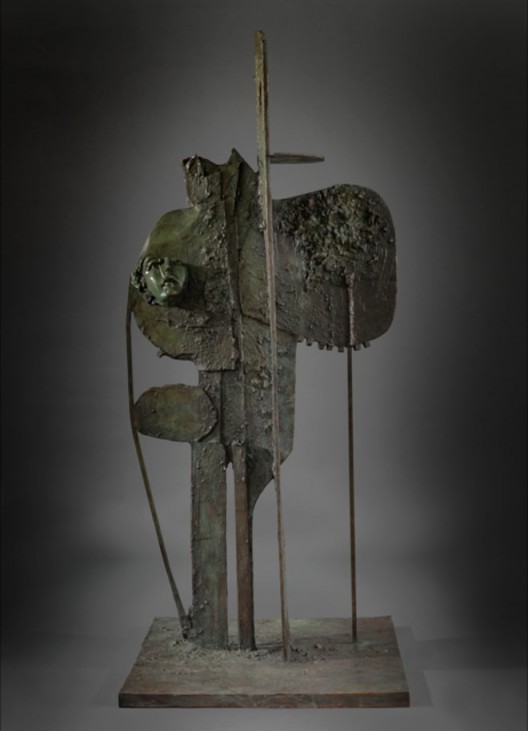
George Condo, “Standing Form with Fragmented Head”, 2017, Bronze,181,6 x 75,6 x 74,9 cm, 71 1/2 x 29 3/4 x 29 1/2, inches, Ed 1/3 + 1 AP, Courtesy of the Artist and Almine Rech Gallery. Photo: Adam Reich
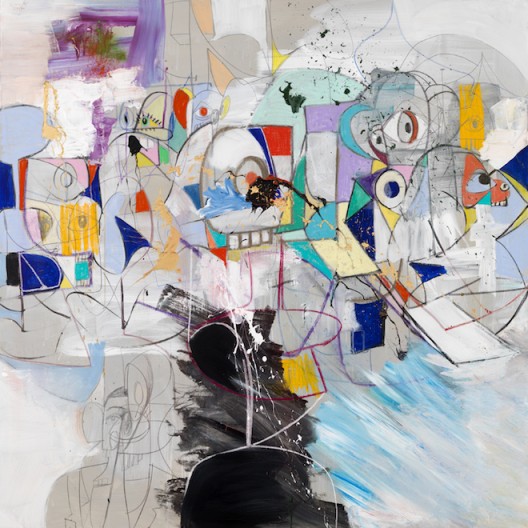
Shipwrecked, 2017
Signed and dated ‘Condo 2017′ (upper left)
Acrylic, metallic paint, charcoal, pastel, graphite and colored pencil on linen Unframed: 177.8 x 177.8 cm (70 x 70 in.)
Framed: 186.1 x 186.1 x 8.9 cm (73 1/4 x 73 1/4 x 3 1/2 in.) (SLG-GC-09771)
Courtesy of the artist and Simon Lee Gallery, London / Hong Kong



